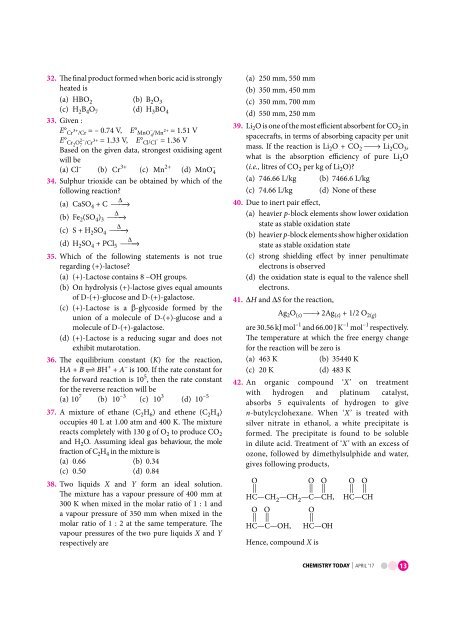Chemistry_Today_April_2017_vk_com_stopthepress
Create successful ePaper yourself
Turn your PDF publications into a flip-book with our unique Google optimized e-Paper software.
32. The final product formed when boric acid is strongly<br />
heated is<br />
(a) HBO 2 (b) B 2 O 3<br />
(c) H 2 B 4 O 7 (d) H 3 BO 4<br />
33. Given :<br />
E° Cr 3+ /Cr = – 0.74 V, E° MnO<br />
–<br />
4 /Mn 2+ = 1.51 V<br />
E° Cr2 O 2– = 1.33 V, E°<br />
7 /Cr3+ Cl /Cl – = 1.36 V<br />
Based on the given data, strongest oxidising agent<br />
will be<br />
(a) Cl – (b) Cr 3+ (c) Mn 2+ (d) MnO – 4<br />
34. Sulphur trioxide can be obtained by which of the<br />
following reaction?<br />
∆<br />
(a) CaSO 4 + C →<br />
∆<br />
(b) Fe 2 (SO 4 ) 3 →<br />
∆<br />
(c) S + H 2 SO 4 →<br />
∆<br />
(d) H 2 SO 4 + PCl 5 →<br />
35. Which of the following statements is not true<br />
regarding (+)-lactose?<br />
(a) (+)-Lactose contains 8 –OH groups.<br />
(b) On hydrolysis (+)-lactose gives equal amounts<br />
of D-(+)-glucose and D-(+)-galactose.<br />
(c) (+)-Lactose is a β-glycoside formed by the<br />
union of a molecule of D-(+)-glucose and a<br />
molecule of D-(+)-galactose.<br />
(d) (+)-Lactose is a reducing sugar and does not<br />
exhibit mutarotation.<br />
36. The equilibrium constant (K) for the reaction,<br />
HA + B BH + + A – is 100. If the rate constant for<br />
the forward reaction is 10 5 , then the rate constant<br />
for the reverse reaction will be<br />
(a) 10 7 (b) 10 –3 (c) 10 3 (d) 10 –5<br />
37. A mixture of ethane (C 2 H 6 ) and ethene (C 2 H 4 )<br />
occupies 40 L at 1.00 atm and 400 K. The mixture<br />
reacts <strong>com</strong>pletely with 130 g of O 2 to produce CO 2<br />
and H 2 O. Assuming ideal gas behaviour, the mole<br />
fraction of C 2 H 4 in the mixture is<br />
(a) 0.66 (b) 0.34<br />
(c) 0.50 (d) 0.84<br />
38. Two liquids X and Y form an ideal solution.<br />
The mixture has a vapour pressure of 400 mm at<br />
300 K when mixed in the molar ratio of 1 : 1 and<br />
a vapour pressure of 350 mm when mixed in the<br />
molar ratio of 1 : 2 at the same temperature. The<br />
vapour pressures of the two pure liquids X and Y<br />
respectively are<br />
(a) 250 mm, 550 mm<br />
(b) 350 mm, 450 mm<br />
(c) 350 mm, 700 mm<br />
(d) 550 mm, 250 mm<br />
39. Li 2 O is one of the most efficient absorbent for CO 2 in<br />
spacecrafts, in terms of absorbing capacity per unit<br />
mass. If the reaction is Li 2 O + CO 2 → Li 2 CO 3 ,<br />
what is the absorption efficiency of pure Li 2 O<br />
(i.e., litres of CO 2 per kg of Li 2 O)?<br />
(a) 746.66 L/kg (b) 7466.6 L/kg<br />
(c) 74.66 L/kg (d) None of these<br />
40. Due to inert pair effect,<br />
(a) heavier p-block elements show lower oxidation<br />
state as stable oxidation state<br />
(b) heavier p-block elements show higher oxidation<br />
state as stable oxidation state<br />
(c) strong shielding effect by inner penultimate<br />
electrons is observed<br />
(d) the oxidation state is equal to the valence shell<br />
electrons.<br />
41. ∆H and ∆S for the reaction,<br />
Ag 2 O (s) → 2Ag (s) + 1/2 O 2(g)<br />
are 30.56 kJ mol –1 and 66.00 J K –1 mol –1 respectively.<br />
The temperature at which the free energy change<br />
for the reaction will be zero is<br />
(a) 463 K<br />
(b) 35440 K<br />
(c) 20 K<br />
(d) 483 K<br />
42. An organic <strong>com</strong>pound ‘X’ on treatment<br />
with hydrogen and platinum catalyst,<br />
absorbs 5 equivalents of hydrogen to give<br />
n-butylcyclohexane. When ‘X’ is treated with<br />
silver nitrate in ethanol, a white precipitate is<br />
formed. The precipitate is found to be soluble<br />
in dilute acid. Treatment of ‘X’ with an excess of<br />
ozone, followed by dimethylsulphide and water,<br />
gives following products,<br />
O<br />
O<br />
HC CH 2<br />
CH 2<br />
C CH,<br />
O O O<br />
HC C OH,<br />
HC<br />
Hence, <strong>com</strong>pound X is<br />
O<br />
OH<br />
O<br />
HC<br />
O<br />
CH<br />
CHEMISTRY TODAY | APRIL ‘17 13


